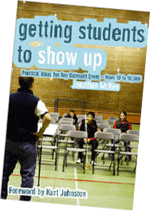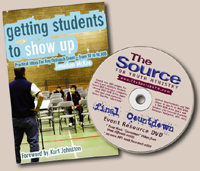| TheSource4YM.com | |
 | Jonathan’s Resource Ezine |
Weekly Resources, Ideas and Articles from The Source for Youth Ministry
Tuesday, September 4, 2007
| If you aren’t a subscriber of this EZINE and would like to subscribe – it’s free – just pop on www.TheSource4YM.com and sign up in the upper right hand corner. |
| Featured Article: “Outreach” that Actually Reaches Out |
 As EZINE subscribers we are bringing you an exclusive excerpt from Jonathan’s new book Getting Students to Show Up. Enjoy Chapter 2 of this book below… and an opportunity to purchase the book from us for only $9.99 where you’ll receive a free OUTREACH RESOURCE DVD just for buying it from us.
As EZINE subscribers we are bringing you an exclusive excerpt from Jonathan’s new book Getting Students to Show Up. Enjoy Chapter 2 of this book below… and an opportunity to purchase the book from us for only $9.99 where you’ll receive a free OUTREACH RESOURCE DVD just for buying it from us.“Outreach” that Actually Reaches Out
By Jonathan McKee
The word outreach is slapped onto the titles of a variety of programs. It’s a buzzword that’s probably thrown around a lot more than it’s actually thought about.
I’ve been to hundreds of “outreach” programs where no reaching out took place. Instead, the purpose of these programs always seemed to be worship or helping Christians grow in their faith. Noble purposes, indeed-but not “outreach” by any means.
I’ve spoken at “outreach” rallies where the first thing out of the emcee’s mouth is “How many of you are here to celebrate Jesus?”
Think about that for a second.
How many students who aren’t believers do you think came to that event to “celebrate Jesus”? Granted, many of these “rallies” are full of Christians who scream in excitement and yell in celebration, so the statement isn’t usually received poorly. But what’s wrong with this picture?
- I see two oversights:
- Why is our audience 90 percent Christians? We’re talking about an outreach program, right? At an outreach program we might want to draw teenagers who don’t believe in Jesus yet. Do you remember Jeff Goldblum’s character in Jurassic Park? During that first uneventful tour of the park, he says, “Now eventually you might have dinosaurs on your dinosaur tour, right?” He taps on the camera. “Hello? Yes?”
So why aren’t the “outreach kids” attending? Didn’t our church kids believe us when we said, “Bring your friends who need to hear about Jesus”? The sad truth: Our audience is often made up of the wrong students. No wonder they didn’t object when we yelled, “How many of you are here to celebrate Jesus?”
Which leads us to our second blunder. - If we’re trying to draw out unbelievers, then why are we talking to them as though they’re already Christians? Imagine you’re asked to emcee the MTV Music Awards. The arena is decorated. All of the hottest artists have walked the red carpet and taken their seats. The crowd is full of screaming music fans. Now the program begins, and you walk onstage and yell, “How many of you are here to celebrate Jesus?”
Awkward.
None of us would yell such a phrase to that crowd. So why do we do it at our “outreach” events?
What if some of the difficulty lies in the fact that we don’t really know much about this “animal” we’re attempting to tame? We’ve never taken the time to really look at our goals for this kind of programming and put it into words. We never took the time to define it.
Maybe we should try to identify exactly whom we’re targeting and what we’re trying to achieve.
Defining an Outreach Program
The following is a sample definition we can use as a tool to keep us accountable to our goal of reaching out. This isn’t THE definition; it’s simply one way to define whom we’re targeting and what we’re trying to achieve.
activity, or program used as a means to
attract those who don’t know Jesus and
point them to Jesus.
Breaking It Down
I’d like to make three key observations about the above definition.
1. You’ll need to decide how you’re going to “point them to Jesus.”
That’s the goal of everything we’re doing here. If “pointing them to Jesus” is our purpose, how are we going to do it?
I know it seems basic, but you’d be surprised by the number of youth events I attend every year where no one knows the purpose of the event. The whole reason most of us do outreach events is so we can point people toward Jesus. I don’t know about you, but I’m really not in the business of feeding teenagers pizza or selling tickets to a basketball tournament. I want to impact students’ lives with the life-changing message of Jesus Christ. So first things first: Figure out how we’re going to point them to Jesus.
The most common way is to share the gospel message. If this is your specific purpose, then everything you do during the program should point toward sharing the gospel. Don’t let anything interfere with it. Don’t let your “cool game” run so long that the speaker has less time to share God’s truth or the counselors don’t have time to meet with students one-on-one.
Sharing the gospel isn’t the only way to point them to Jesus. Chapter 3 will show us several different examples of how to do it, and it will also guide us through the process of selecting our purpose and keeping our eyes fixed on that goal.
But purpose isn’t the only important part of this definition.
2. You need a draw to “attract those who don’t know Jesus.”
We can’t achieve our purpose if no one is there. What will get them there? Our definition says we need to “attract those who don’t know Jesus.” How are we going to do that? What will attract them?
One of the most neglected elements I see in programs across the country is draw. Most people just book a band and a speaker. Sound familiar?
Forget about our church kids for a second. Have we ever stopped to ask a teenager who’s never been to church if he’s even remotely interested in coming out to listen to some Christian band and Jonathan McKee? His answer would probably be, “Who and who?”
So what works? Don’t worry. In chapter 4 we’ll not only reinforce the necessity of draw, but we’ll also give several examples that work.
But the definition doesn’t end with purpose and draw. It also talks about our target audience. Hence, my third observation about our definition of outreach program follows.
3. Remember: Your audience is “those who don’t know Jesus.” So don’t treat them like they do!
One of the worst things we can do to non-Christians is make them feel like they don’t belong. Yet we do it all the time.
 I won’t spend a lot of time on this point. I devoted an entire book to the subject of understanding and reaching unchurched teenagers called Do They Run When They See You Coming? Reaching Out to Unchurched Teenagers (Youth Specialties/Zondervan, 2005). But if our audience is filled with “those who don’t know Jesus,” we shouldn’t talk to them as if they’ve grown up in the church. They didn’t come to worship God. Why do we assume they did? They’re probably there because some cute sophomore invited them, or they heard free pizza was being served.
I won’t spend a lot of time on this point. I devoted an entire book to the subject of understanding and reaching unchurched teenagers called Do They Run When They See You Coming? Reaching Out to Unchurched Teenagers (Youth Specialties/Zondervan, 2005). But if our audience is filled with “those who don’t know Jesus,” we shouldn’t talk to them as if they’ve grown up in the church. They didn’t come to worship God. Why do we assume they did? They’re probably there because some cute sophomore invited them, or they heard free pizza was being served.So don’t talk to them in a language they don’t understand. They don’t know what “salvation” is. They don’t know what a “testimony” is or even what the word Christian means. After all, 81 percent of Americans claim to be “Christian.” But where are they every Sunday? Do you think they know what that word really means?
Don’t talk about “non-believers” or “the lost.” Prep the speakers, the emcee, and the band not to talk about how we “need to be a light to non-Christians.” “Psssst! Stop talking about them! They’re sitting right there!”
And as we mentioned earlier in the chapter, don’t turn it into a pep rally for believers. Don’t start the event with an emcee onstage hyping up the audience with, “HOW MANY BELIEVERS WE GOT IN DA HEY-OUSE?!” If there is a non-Christian there (and hopefully there’s at least one present, since this is an outreach event), how is she supposed to respond? Why not just yell, “Hello, Cincinnati!” Or, if you want to pump it up like a pep rally, break it down by grade. “How many freshmen we got in the house?”
The key to reaching our audience is knowing our audience. And the 411 on any outreach audience is this: They don’t know Jesus. So don’t treat them as though they do.
Define It
Now we have a working definition for an outreach program that identifies precisely whom we’re targeting and exactly what we’re trying to achieve.
activity, or program used as a means to
attract those who don’t know Jesus and
point them to Jesus.
With this groundwork in place, let’s look at “how” we’re going to get students to show up.
AND GET A FREE OUTREACH RESOURCE DVD
TABLE OF CONTENTS
Where It All Begins
Chapter 1: The Field of Dreams Myth
If You Build It, They Will Come…Right?
Chapter 2: Aligning Our Defining
“Outreach” That Actually Reaches Out
Chapter 3: Doing It “On Purpose”
Pointing Where We Want to Point
Chapter 4: Jell-O Wrestling, Root Beer Kegs, and Slam Dunks
The Importance of “Draw”
Chapter 5: Staring at a Blank Piece of Paper
The Planning Process-Starting from Scratch
Chapter 6: “What” Happens “When”
Planning Our Program Agenda
Chapter 7: Programming On-Campus Outreach Clubs
Student- and Adult-Led Campus Ministry Programming
Chapter 8: Planning Weekly Outreach Programs
Planning Effective Outreach Programs Week after Week
Chapter 9: Programming Large Events
Reaching Out with a Larger Scope-Citywide Events
Chapter 10: Sidestepping Speakers Who Just Don’t “Get It”..
. …and Booking Speakers Who Do
Chapter 11: Bypassing Bands That Just Don’t “Get It”…
…and Booking Bands That Do
Chapter 12: Slam Dunks
Ten Outreach Programs and Events That Work
Epilogue: Making It Happen
Where Do We Go from Here?
Chapter 1: The Field of Dreams Myth
If You Build It, They Will Come…Right?
Chapter 2: Aligning Our Defining
“Outreach” That Actually Reaches Out
Chapter 3: Doing It “On Purpose”
Pointing Where We Want to Point
Chapter 4: Jell-O Wrestling, Root Beer Kegs, and Slam Dunks
The Importance of “Draw”
Chapter 5: Staring at a Blank Piece of Paper
The Planning Process-Starting from Scratch
Chapter 6: “What” Happens “When”
Planning Our Program Agenda
Chapter 7: Programming On-Campus Outreach Clubs
Student- and Adult-Led Campus Ministry Programming
Chapter 8: Planning Weekly Outreach Programs
Planning Effective Outreach Programs Week after Week
Chapter 9: Programming Large Events
Reaching Out with a Larger Scope-Citywide Events
Chapter 10: Sidestepping Speakers Who Just Don’t “Get It”..
. …and Booking Speakers Who Do
Chapter 11: Bypassing Bands That Just Don’t “Get It”…
…and Booking Bands That Do
Chapter 12: Slam Dunks
Ten Outreach Programs and Events That Work
Epilogue: Making It Happen
Where Do We Go from Here?
In the next few months many of us are kicking off a weekly program or big event in our ministry. Do we just book a band and a speaker? Is there more? What if kids don’t show up?
Look no further… we’ve got the resource you’re looking for-the new playbook for planning outreach events.

ORDER NOW AND GET THE

Event Resource DVD
FREE!
Right now you can get a free OUTREACH RESOURCE DVD for free just by ordering the new book that everyone is talking about. “Getting Students to Show Up” is recommended by Kurt Johnston, Dan Kimball, Wayne Rice, Jim Burns, Scott Rubin, Les Christie and more.
TO ORDER THIS BOOK
HELPING YOU STEP BY STEP:
Getting Students to Show Up will challenge you to rethink your methodology when it comes to outreach. But more than that, it’ll show you, step-by-step, how to plan and execute a great outreach event for 10 or even 10,000 students. Whether you’re going for a city-wide shindig or a weekly gathering for your church or a campus, you’ll find plenty of tips and tools inside that will ensure your event actually reaches out to your demographic and points them toward Jesus.
You know how we at THE SOURCE like to give you free stuff! So we put together this spectacular DVD for you with three different countdown videos and a few other extras you’ll enjoy!
TO ORDER THIS BOOK
 Jonathan McKee is president of The Source for Youth Ministry and author of numerous youth ministry books like “Do They Run When They See You Coming?” and the brand new “Getting Students to Show Up.” Jonathan studies youth culture and trends, speaking and training across the country and providing free online resources, training, & ideas for youth workers at www.TheSource4YM.com
Jonathan McKee is president of The Source for Youth Ministry and author of numerous youth ministry books like “Do They Run When They See You Coming?” and the brand new “Getting Students to Show Up.” Jonathan studies youth culture and trends, speaking and training across the country and providing free online resources, training, & ideas for youth workers at www.TheSource4YM.comDelivered free via e-mail to subscribers each week. We encourage you to distribute this newsletter freely and ask only that you not change its contents.
HAVE YOU MISSED PAST “EZINE” ARTICLES?
CLICK HERE FOR JONATHAN’S “EZINE” ARCHIVES
And for more FREE resources and ideas … go to THE SOURCE
www.TheSource4YM.com
Copyright ?2007 The Source for Youth Ministry
All rights reserved.
Jonathan McKee
Jonathan McKee is the author of over twenty books including the brand new The Guy's Guide to FOUR BATTLES Every Young Man Must Face; The Teen’s Guide to Social Media & Mobile Devices; If I Had a Parenting Do Over; and the Amazon Best Seller - The Guy's Guide to God, Girls and the Phone in Your Pocket. He speaks to parents and leaders worldwide, all while providing free resources for youth workers on TheSource4YM.com. Jonathan, his wife Lori, and their three kids live in California.
